Research
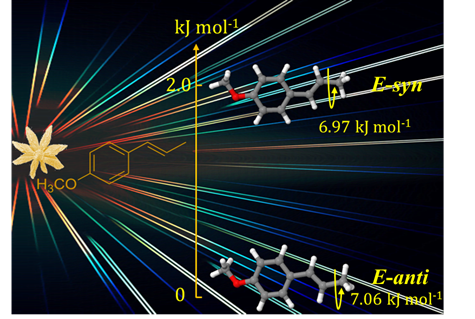
Molecules and Biomolecules
Investigation of structure, conformational and tautomeric equilibria, nuclear field gradients, electric dipole moments, potential energy surfaces of isolated molecules by microwave spectroscopy.
References:
Conformational Equilibrium and Internal Dynamics of E-Anethole: A Rotational Study.
C. Calabrese, Q. Gou, A. Maris, S. Melandri, W. Caminati, J. Phys. Chem. B 120 (2016) 6587-6591. http://dx.doi.org/10.1021/acs.jpcb.6b04883
Structure of saligenin: microwave, UV and IR spectroscopy studies in a supersonic jet combined with quantum chemistry calculations.
S. Kumar, S.K. Singh, C. Calabrese, A. Maris, S. Melandri, A. Das, Phys. Chem. Chem. Phys. 16 (2014) 17163-17171. http://dx.doi.org/10.1039/c4cp01693a
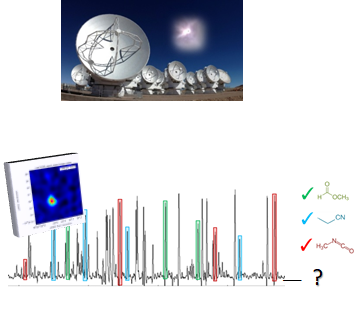
Laboratory Astrochemistry
Through the recognition of the rotational spectral lines, radioastronomy represents one of the most important techniques for the unequivocal detection of complex organic molecules in circumstellar envelopes and interstellar medium.Laboratory data are essential to interpret the spectra collected from radio-telescopes especially those of new generation ones such as Alma (Atacama Large Millimeter Array)
References:
Accurate spectroscopy of polycyclic aromatic compounds: From the rotational spectrum of fluoren-9-one in the millimeter wave region to its infrared spectrum.
A. Maris, C. Calabrese, S. Melandri and S. Blanco, J. Chem. Phys. 142 (2015) 024317. http://dx.doi.org/10.1063/1.4905134
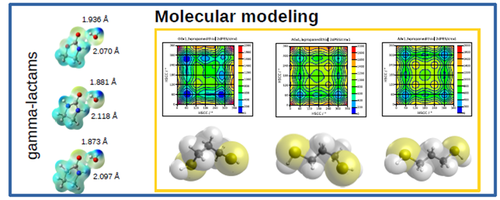
Modeling
Rotational data can be directly compared to theoretical data calculated in the isolated phase. Extensive modeling is essential for the correct interpretation of the results.
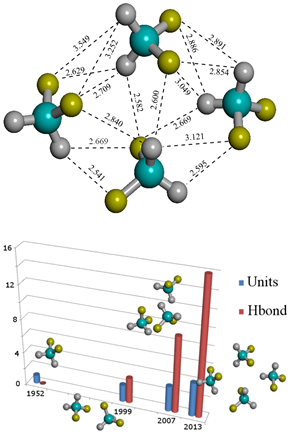
Non Covalent Interactions
A wealth of structural and dynamical information can be obtained from the study of high resolution spectra of molecular clusters generated in a cold supersonic expansion by means of highly resolved spectroscopic methods. The data obtained, generally lead to the determination of the structures of the stable conformations. In addition, in the case of weakly bound molecular complexes it is usual to observe the effects of internal motions due to the shallowness of the potential energy surfaces involved and the flexibility of the systems
Microsolvation
A wealth of structural and dynamical information can be obtained from the study of high resolution spectra of molecular clusters generated in a cold supersonic expansion by means of highly resolved spectroscopic methods. The data obtained, generally lead to the determination of the structures of the stable conformations. In addition, in the case of weakly bound molecular complexes it is usual to observe the effects of internal motions due to the shallowness of the potential energy surfaces involved and the flexibility of the systems
References:
High-Resolution Spectroscopic Studies of Complexes Formed by Medium-size Organic Molecules.
M. Becucci and S. Melandri, Chem. Rev. 116 (2016) 5014-5037. http://dx.doi.org/10.1021/acs.chemrev.5b00512
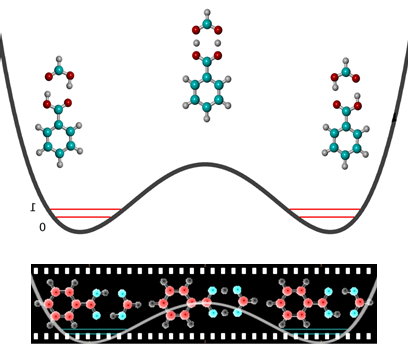
Proton transfer
Tunneling effects have been measured in the pulsed jet Fourier transform microwave spectra of dimers of the carboxylic acid bimolecule. The tunneling splittings are originated by the concerted proton transfer of the two carboxylic hydrogens. From the values of these splittings for the OH−OH and OD−OD species, it is possible to model/size the barrier to the concerted double proton transfer.
References:
Proton Tunneling in Heterodimers of Carboxylic Acids: A Rotational Study of the Benzoic Acid-Formic Acid Bimolecule.
L. Evangelisti, P. Ecija, E.J. Cocinero, F. Castano, A. Lesarri, W. Caminati, R. Meyer, J. Phys. Chem. Lett. 3 (2012) 3770-3775. http://dx.doi.org/10.1021/jz3018489
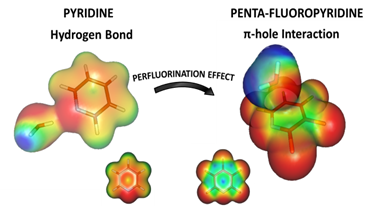
Tuning of molecular properties
Tuning of molecular properties through understanding the effects of atom or molecular group substitutions is a very important research theme in chemistry. In many cases the properties of molecules in the condensed phase are affected by non-covalent interactions, such as those occurring with the solvent or with reacting partners or in the case of drugs with their receptors. Study at the molecular level of how the substitution of atoms can change intermolecular interactions is particularly interesting.
References:
Probing the Lone Pair•••π-Hole Interaction in Perfluorinated Heteroaromatic Rings: The Rotational Spectrum of Pentafluoropyridine•Water.
C. Calabrese, Q. Gou, A. Maris, W. Caminati, S. Melandri, J. Phys. Chem. Lett. 7 (2016) 1513-1517. http://dx.doi.org/10.1021/acs.jpclett.6b00473
Group meetings
05/09/2022
Wentao Song: PGOPHER
18/07/2022
Andrea Maggio: Rotational spectrum of dimethylsilane
Fufei Sun: Rotational spectrum of 3-chloropropanoic acid
06/06/2022
Wentao Song: Experimental activity in Nick Walker's laboratory
Emanuele Pizzano: NIRS
13/05/2022
Giovanna Salvitti: Non covalent interactions described through electron density